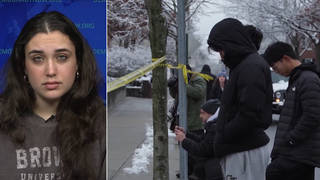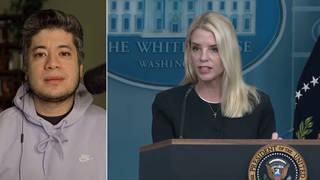
Democracy Now’s Juan Gonzalez looks back at the 1980 pro-democracy uprising that ended when South Korean soldiers opened fire. The official body count was 500. Some human rights groups have estimated the number of dead as high as 2,000. Despite his public policy of supporting human rights, U.S. President Jimmy Carter refused to back the pro-democracy protesters in South Korea. [includes rush transcript]
Democracy Now! co-host Juan Gonzalez’s column “Freedom Bid That Shames Us” ( Daily News, May 17, 2005):
Kim Hyo Seok was just a high school teenager that day in May 1980 when Special Forces arrived before dawn and surrounded the downtown YMCA where he and other pro-democracy protesters had barricaded themselves for several days.
Within minutes, the soldiers opened fire with their tanks and M-16s. By the time the smoke had cleared a few days later in the city of Kwangju, the official body count had passed 500. Some human rights groups have estimated the number of dead as high as 2,000.
No one knows for sure.
What we do know is that young Kim was arrested by soldiers and thrown into prison with hundreds of others, and that Gen. Chun Doo Hwan, who ordered the attack on Kwangju, became the next in a line of South Korean dictators dating to the end of World War II.
The general had assumed power in late 1979 after a previous dictator was assassinated. Instead of allowing democratic elections, he declared martial law. Then in May 1980, he closed the country’s universities, arrested all major political opponents and imposed strict press censorship.
Among those he jailed was South Korea’s most famous dissident, Kim Dae Jung, who came from just outside of Kwangju.
Thousands of university and high school students poured into the streets of that city on May 18 to demand democratic elections and the release of Kim Dae Jung.
Police violence against the demonstrators resulted in two deaths and scores of injuries. The repression so inflamed the population that hundreds of thousands of residents joined in massive demonstrations that paralyzed the city.
“When we saw all the lies in the media, calling us students thugs and criminals, it made us even angrier,” Kim Hyo Seok told me yesterday.
The demonstrators soon overran government buildings and trashed the two main television stations.
On May 22, William Gleysteen, U.S. ambassador to South Korea, wrote in a cable to President Jimmy Carter’s security advisers: “Kwangju is … out of control and poses an alarming situation for [the Korean] military … at least 150,000 people are involved.”
Despite his public policy of supporting human rights, Carter refused to back the massive democracy uprising in South Korea. At that very moment, the United States was facing a huge crisis in Iran, following the uprising that brought Ayatollah Khomeini to power.
In public, the Carter administration condemned the bloody attack on Kwangju. But in private, White House officials feared Korea would spin out of control. Carter’s top aides quietly backed Gen. Chun’s use of South Korea’s Special Forces to gain control of Kwangju.
The full story of this sellout of Korea’s democracy movement was uncovered a few years ago in the “Cherokee files,” thousands of secret documents about the Kwangju events that our government released in a Freedom of Information request from Journal of Commerce reporter Tim Shorrock.
After democracy finally came to South Korea in the late 1980s, Gen. Chun was put on trial and jailed for treason for his role in the Kwangju massacre.
The protesters who died in the uprising were all declared martyrs for democracy, and the South Korean government has paid compensation to more than 4,000 who suffered injuries.
Kim Dae Jung, the dissident whose arrest touched off the uprising, was elected president in 1997 and won the Nobel Peace Prize a few years later for his efforts to end the divisions between North and South Korea.
As for Kim Hyo Seok, the high school student who was arrested at Kwangju, he now heads Light of May, a Korean human-rights organization, and is co-chairman of his nation’s Truth and Reconciliation Commission.
This month, on the 25th anniversary of Kwangju, Kim Hyo Seok is touring the United States, telling the story of a fight for democracy few Americans have heard about. One that triumphed even when our government turned its back.
Transcript
AMY GOODMAN: As we wrap up today, we wrap up on the 25th anniversary of the Kwangju Massacre. Juan, you wrote a very compelling piece yesterday in The New York Daily News. You can talk about the significance of what took place in Korea?
JUAN GONZALEZ: Well, the Kwangju Massacre and the uprising that lasted for about ten days from May 18 to May 28, 1980, is a moment in Korean history and in the movement for democracy that is not generally very well known in the United States, but in that period of time, the — first the students and then the entire city of Kwangju, South Korea, a city of about 800,000 people at the time, rose up demanding democracy because there had been martial law imposed by a general at the time, Chun Du Hwan. And they were demanding free elections. They were demanding an end to martial law. All unions had been banned at the time, and political assembly. And as a result, the South Korean military called in special forces, and they massacred — the estimates are between 500 and 2,000 people in a battle to over — to retake the city, because the whole city had become liberated as a result of the protest.
And most importantly is that our government, that — at the time Jimmy Carter was president — supported, secretly supported the efforts to bring order into Kwangju, specifically because it was then battling the Khomeini regime. There had just been a revolution in Iran. So Jimmy Carter, despite his human rights position, decided that they could not afford to have another country erupt in unrest so soon after the Iran revolution. So, as a result the Carter administration backed the Korean army in repressing and essentially massacring its people. So that there are several now human rights leaders from South Korea who are touring the country to remind Americans about the role of the U.S. government at that time and to bring the issue of Kwangju and what Kwangju represents, because one of the people arrested at that time was Kim Dae Jung, who eventually became the President of Korea and the Nobel Prize winner. He was born right outside of Kwangju. And, in fact, one of the demands of the students who poured out into the streets that day was that he be freed from jail, because he had just been arrested one more time by the South Korean government.
AMY GOODMAN: Very much the launch of the modern-day Korea democracy movement.
JUAN GONZALEZ: It started then. And given how much President Bush is talking about human rights and democracy around the world, it’s good to remember what Kwangju represented for the Korean people.













Media Options